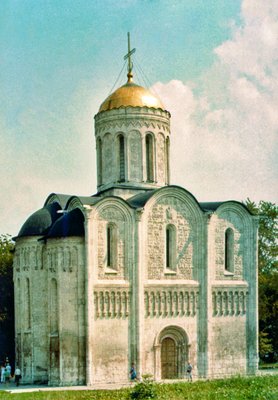The first image is from the south façade of Cathedral of Dimitry of Solunsk from Vladimir (an old Russian city some 200 km east of Moscow). The Cathedral was finished in 1197 AD. By the way, Solunsk is a Russian version of Thessaloniki and this Russian Cathedral has its counterpart in Thessaloniki – Church of Agios Dimitrios (Ιερός ναός Αγίου Δημητρίου).

The composition is called “Ascension of Alexander the Great to Heaven”. The choice of Alexander for the Russian cathedral of XII century might seem strange but the king’s name and his deeds were very popular in Russia [more correctly Rus, of course] at that period due to the Byzantine “Alexandria” translated into many languages, Russian included. “In a church sculpture of the second half of XII century [in Russia] the ascension of Alexander can be viewed on equal terms with most important Christian images,” writes Prof. B.A.Rybakov.
This particular image shows two griffins carrying the king on their wings. Alexander sits in a wicker basket and holds lion cubs in his hands – a bait for the griffins. The legendary birds try to reach for the cubs and as a result lift up Alexander into the sky.
Below you can see a general view of the Cathedral and also a more close up image of Alexander.


A close up image of Alexander seems to me a bit different than in a main panel above, I went through several google images for both, and they all say the same. Maybe a smaller image is a separate vignette from other part.
Another image of Alexander, this time as part of jewelry, the so called "Sahnovskaja diadem”

This gold diadem was part of the buried treasure found in 1900 in the village Sahnovka (near Kiev in Ukraine). It is decorated with cloisonné (decorative work in which enamel, glass, or gemstones are separated by strips of flattened wire placed edgeways on a metal backing) and considered to be work of Kiev jewelers of the XII century. It consists of seven plates with the total length of 35 cm. On both sides there are smaller plates with hooks (you can’t see them in this photo) for special decorative chains hung vertically.
Alexander’s ascension is the subject of central plate of this diadem. It seems that it was a popular design because a similar diadem (with Alexander’s ascension) was found in Preslav (a capital of the Bulgarian king Simeon I the Great ruled 893 to 927). Here is a link to a brief description, in English, of the Preslav treasure and an image of the central plate with ascension of Alexander. http://www.goldensands.bg/cultural/treasure-preslav.asp The article mentions the diadem, above, found in Kiev.
The golden diadem like that would be worn by the tsar’s wife only on the special occasions. The diadems of the time had a special sacred meaning because the head of the tsar’s wife should have been protected by the main heavenly powers. There are also speculations that the subject of ascension of Alexander was supposed to mask still existing pagan beliefs prevalent in Rus in previous centuries. Alexander was identified with Dajdbog, one of the main pagan Slav deities. Funny enough, though Dajdbog actually translates as god of rain, he is actually considered Russian counterpart of Apollo (Hyperboreans, anybody?).
Here is a short paragraph [again, translation is mine] from the Russian version of Alexandria. It is written in a very old Russian so English translation also a bit of awkward, somewhat mimicking the style of those bygone centuries:
“…Alexander, son of Apollo. …And Romans pray to their god Apollo in his temple so that he would announce the birth of his son Alexander. And Apollo comes to them in their sleep and says “Warriors of the Great Rome! Don’t fear Alexander, he is my son.” “
Not sure how Alexander himself would react to such a parentage but…..
I hope you find this information interesting.
Happy New Year everybody!
